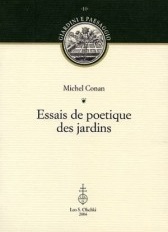In the Poetics, Aristóteles established the theory of literary genres in the context of a discussion of the “creation of things,” starting from two questions about mimesis: how to imitate and what to imitate. He observes that there are three modes of mimesis: the media of imitation, the objects of imitation, and the ways of imitating. These observations by Aristoteles lay at the root of western culture and gave rise to what came to be known as “fiction.” And from fiction (our dramatical theater) it became metaphor.
Such were the first ideas that came to mind when reading the text by Conan. Why does a poetic genre engage almost instantly with another one? These essays about the poetics of gardens bring together 17 articles (some already in print, others not) written during the last 30 years by this cultural researcher. Truly, what is the history of gardens but the history of a fundamental aspect of culture?
These chapters are organized around four themes: the poetic texture of gardens, the creation of gardens, life in gardens, and gardens as melting pots of culture. It offers 426 pages that lead from the metaphysics of water to the labyrinth of Versailles; from the gardens in the French manner of the 17th c. to the contemporary landscapes created in working class suburbs; from the “classic” gardeners such as Le Nôtre and André Mollet to the utopian Gabriel Thouin, and the renovator Bernard Lassus; from individual to collective creation; from gallantry to landscape metaphor; from the literary approach of La Fontaine to relationships between nature and politics. This is to say the large fan of examples that is presented in order to explain, or better, to expose “the confession of a personal choice of a few questions to which my writings always made me return,” as Conan says in his introduction.
It is good to be offered the freedom to either read each chapter in any order, or as a link in a chain of essays while trying to discover proximities or distances with our own cultural predilections. So, it will be easy to agree or disagree with my initial Aristotelian perspective.
Conan’s reflexions take on the discovery – beyond forms and materials – of the meanings, the metaphors, and the fictions in gardens of all times and latitudes. Without any leanings towards determinism, he proposes to use an anthropological concept of human conduct in gardens, whether by the creators or visitors, as a departure point for a confrontation with our times and our everyday life.
“Gardens always are fragile ecosystems that survive when monitored by humans trying to mold nature to some cultural end. Human culture does not oppose nature as much as it transforms it by appropriating and adapting it to its ends. The garden offers an infinite source of metaphors to evoke the greatest refinements of culture, the poetics of life.”
All these thoughts are expressed in a chosen French language, supported by a large number of black and white and a few color illustrations that enliven the presentations, bringing visual dimensions to the pursuit of knowledge.
In a word, this is compulsory reading for academics interested in urban history, social history, art history, cultural history... and why not in garden history!



![[Imagem da capa]](https://vitruvius.com.br/media/images/magazines/grid_9/6a7717753474_resenha115.jpg)
![[Imagem da capa]](https://vitruvius.com.br/media/images/magazines/gallery_thumb/6a7717753474_resenha115.jpg)

